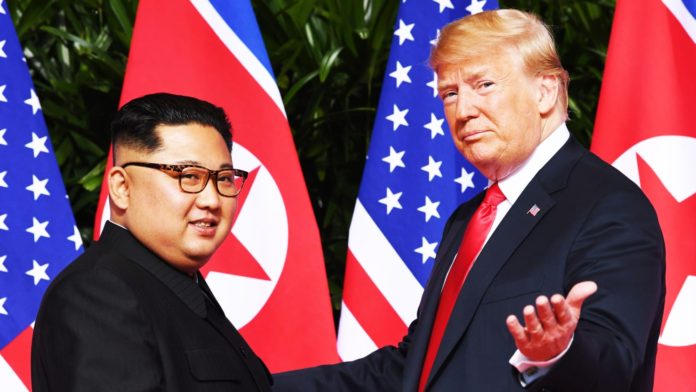Maria Ryan, University of Nottingham
While Donald Trump’s political inexperience and his thin-skinned, irascible temperament led him to threaten North Korea with nuclear war in 2017, this year he has taken a more constructive path by agreeing to something that no other president before him would: a summit meeting with the North Korean leader, Kim Jong-un, without preconditions, to discuss the north’s nuclear programme and the future of the US-North Korean relationship.
The meeting – which was deftly brokered by the South Korean leader, Moon Jae-in, not by Trump – is set to begin in Singapore on June 12. Neither Trump nor Kim has much experience of high-stakes political summitry – and the hasty organisation of this meeting left little time for the advance diplomacy that typically occurs for months before a formal summit. Predicting the outcome is therefore even tougher than usual.
Both sides appear to understand that there are three interconnected issues on the table: denuclearisation (most important for the US), security normalisation (most important to North Korea), and economic normalisation (potentially benefiting both but especially important for Pyongyang).
Yet while both sides agree that these are the core objectives, previous accords have broken down because of disagreements over what these things actually mean in practice and over the timeline for implementation. As always, the devil will be in the detail.
Denuclearisation
North Korea will not accept a so-called “Libya model” where it would give up its weapons in advance of getting anything in return from the US. It wants a reciprocal step-by-step process in which North Korean concessions are met with substantive US commitments in other related areas.
Timing and verification will be key: when will each step towards dismantling nuclear facilities take place and when will the US follow through with reciprocal commitments of its own? At what point in the process will North Korea allow international inspectors into the country to verify its denuclearisation and what sites will they have access to? These have been sticking points for years.
In addition, if the ultimate aim is to fully denuclearise the Korean Peninsula, what will become of the US’s nuclear security guarantee to South Korea? It seems highly unlikely that the north would be happy for the US to maintain a defensive nuclear alliance with the south that is essentially directed against Pyongyang.
Security
One of Kim’s chief objectives is to sign a peace treaty to finally end the 1950-53 war with the US, which has been frozen under an armistice for more than six decades. It does seem that a peace treaty is at least under discussion: after a recent meeting with a very senior North Korean official, Kim Yong-chol, Trump announced) that they “talked about ending the war … That’s something that could come out of the meeting”.
For North Korea, normalising the security situation may also mean limiting US military activity on the Korean Peninsula. Washington has more than 28,000 troops stationed stationed in South Korea across 11 military bases, and conducts military exercises with Seoul that are notionally rehearsals for combating potential North Korean aggression. The continuation of these “provocative” exercises recently drove the north to cancel talks with the south, though those were apparently resuscitated soon afterwards.
Given Trump is resentful about coughing up millions of dollars to station large numbers of US troops abroad for the benefit of other countries – a somewhat distorted view – it’s possible that he may be willing to accept a reduced US military presence in the region.
Economy
The North Korean regime wants some degree of global economic integration, if only to ensure its own survival – if the Kim government is to endure, it needs to offer its people some material progress, much as China has. To this end, the South Korean government has even laid out a “new economic road map for the Korean Peninsula” should Pyongyang denuclearise.
The US also appears to now understand the importance of economic normalisation: in the run-up to the summit, Trump has already put “hundreds” of new US sanctions on hold. The US will also need to commit to rescinding other sanctions – but when exactly? Again, timing will be everything.
What’s different this time?
The fact that Trump agreed to meet Kim without preconditions is hugely significant. Past US presidents had always insisted Pyongyang give up its nuclear capability in advance of a meeting – that Trump did not means any agreement is likely to be more reciprocal than other US efforts. And in recent years, North Korean officials have repeatedly stated that the regime will seriously consider denuclearisation provided the US makes security guarantees and lifts trade restrictions.
![]() Nobody expects this to be easy – and the mood heading into the talks seems sober. Trump’s secretary of state, Mike Pompeo, has acknowledged that success will require “big and bold” decisions on both sides. And Trump himself has played down hopes that the summit can solve all bilateral problems in one go: “It will be a beginning… I’ve never said it happens in one meeting. You’re talking about years of hostility; years of problems.” For once, he may be right.
Nobody expects this to be easy – and the mood heading into the talks seems sober. Trump’s secretary of state, Mike Pompeo, has acknowledged that success will require “big and bold” decisions on both sides. And Trump himself has played down hopes that the summit can solve all bilateral problems in one go: “It will be a beginning… I’ve never said it happens in one meeting. You’re talking about years of hostility; years of problems.” For once, he may be right.
________________________________________________
Maria Ryan, Lecturer in American History, University of Nottingham
This article was originally published on The Conversation. Read the original article.
































































